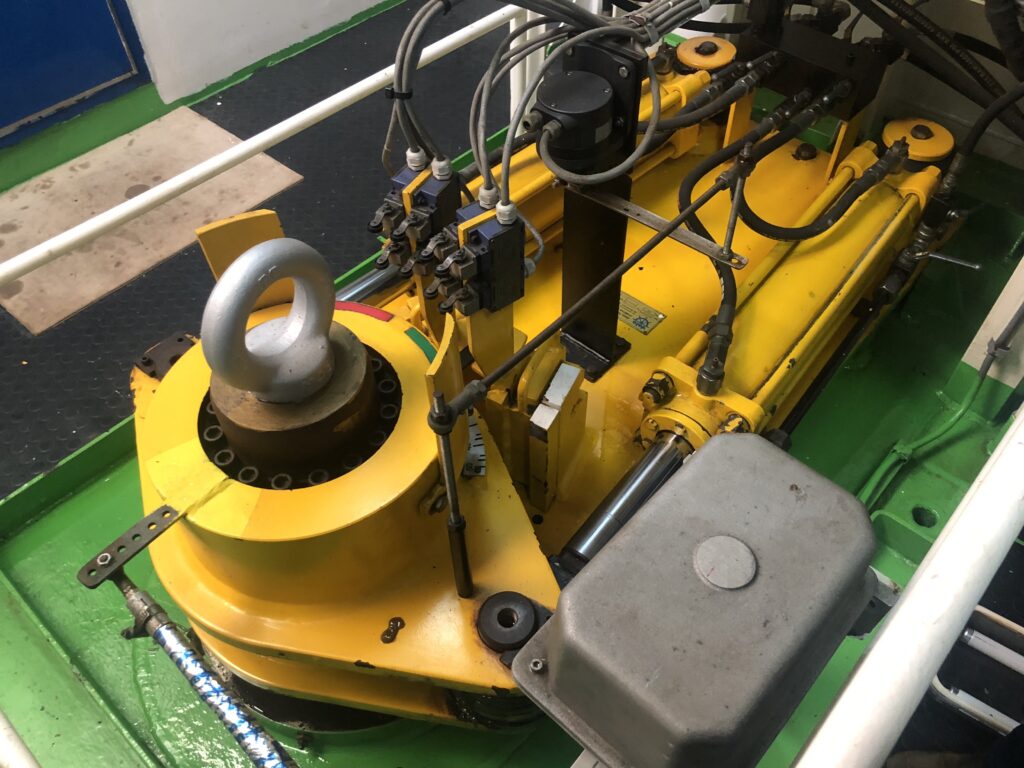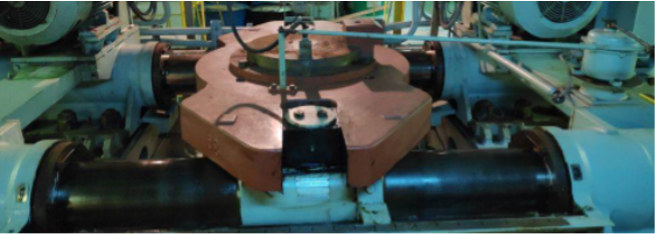The telemotor in the steering gear is a hydraulic control system consisting of a receiver, transmitter, pipes, and a charging unit. The transmitter is located on the bridge which is built on the steering wheel console.
The bridge commands the transmitter to send a signal to the receiver, which is installed on the steering gear’s top. When the receiver receives the signal, it uses hydraulic power to move the pipe and charging unit, thus giving the desired motion to the rudder, whether it’s towards the port or starboard side.

Steering gears are installed on ships to provide direction to whether port side or starboard side depending on the order from the bridge. Steering gears are standstill when the ship is not in motion, and this is the time when maintenance can be carried out to keep the equipment healthy.
Moreover, a propeller is a device that gives thrust to the ship forward or backward but with the help of the rudder which is located at the end of the steering gear, it can help in changing the ship’s course and direction.
What Is The Function Of Telemotor?
The signal of the order rudder angle is compared with the feed angle at the steering stand on the bridge and its deviation signal is transformed into the pump control signal in the control box. By this signal, the torque motor is driven, and the hydraulic pump hydraulic regulator.
The oil is consequently discharged from the hydraulic pump and applied to the hydraulic cylinder, and the tiller will be rotated through the ram and the ram pin. Moreover, the cylinder unit has a control spindle that is connected to it by a pin. This control spindle provides motion to the swash plate of the variable delivery pump and the slipper ring.
However, manual control of the steering is made possible by removing the changeover pin from the cylinder unit and inserting it into the local handwheel drive of the steering gear system.
Interlocks are also fitted on the steering gear system to limit the movement on the rudder angle range. In addition, pressure sensors and level sensors are fitted also to notify the crew if there is any loss of hydraulic oils by raising an alarm.
The normal working pressure is about 20 to 30 bars depending on the manufacturer’s specifications. In order not to exceed these given pressures and strain the gears, the wheel must not be operated and forced beyond the hard over the position.
The replenishing tank of the steering gear must be checked regularly as well as the lubrication points. Any leaks or damage to the equipment must be repaired as soon as possible because the steering gear system is considered one of the emergency equipment on board.
Air venting must be done accordingly if there are reports of slow and sluggish responses from the steering wheel to the steering gear. Moreover, if sluggish response can’t be rectified by air venting, the oil must be replaced by new oil.
What Are The Types Of Telemotor?
The telemotor has three types, the most common type of telemotor that is installed onboard modern ships is the electro-hydraulic type. This kind of system uses both electric and hydraulic as means of moving the steering gear.
Meanwhile, the other two types use electric type and the other one is a hydraulic type kind of telemotor.
Parts Of Telemotor Unit?
The telemotor is made up of two parts namely, the transmitter and the receiver.
Transmitter
The transmitter is located on the navigation bridge in the form of a wheel. This is where the order will be given whether to port or starboard side. Moreover, the transmitter is made up of a cylinder with a pedestal base which consists of a piston that is operated by a rack and pinion from the steering wheel.
Receiver
The signal that is transmitted from the bridge is given to the receiver, which is located in the steering gear compartment. After receiving the signal, it conveys this order to the control unit, which is also located in the steering gear compartment.
The receiver rams are fixed and any displacement of the fluid causes the cylinder body to move to the desired order of movement by compressing the springs. The compressed springs served to return the receiver thus returning to midship on the steering wheel on the bridge when released.
The tanks must be monitored and kept topped up with a non-freezing working fluid which is normally a mineral oil with low viscosity to avoid rusting from the inside. With this routine, minimal to major problems can be avoided in the future.
Parts Of Steering Gear?
The steering gear plays a vital role on board the ship, that’s why it is needed to maintain the parts of the steering gear. The steering gear is made up of the telemotor, control unit, and power unit.
Control unit
The control unit is the link between the telemotor and the power unit. The signal that is given by the telemotor goes to the control unit and operates the power unit until the signal is acknowledged.
Telemotor
It is the one that is built on the bridge that gives an order to the control unit. The order that is given by the helmsman is then sent to be executed on the local side of the steering gear.
Power unit
The function of the power unit is to execute and amplify the order given by the telemotor. It is the one that moves the rudder to give direction and course for the ship to reach its destination.

Preventive Measures Against Steering Gear Failure
Having problems with steering gear is very alarming, especially when the ship is on a channeling course or a traffic sea passage.
However, to avoid further incidents, the Classification Societies and SOLAS made up conventions and standards for the steering gear system to ensure the safety of the ship and its crew.
- Ships must have a main and auxiliary steering gear so that the failure of one does not render the other inoperative. An auxiliary steering gear need not be fitted, however, when the main steering gear has two or more identical power units and is arranged such that after a single failure in its piping system or one of its power units, steering capability can be maintained. To meet the latter, the alternative steering gear has to comply with the operating conditions.
- The main steering gear must be able to steer the ship at maximum ahead service speed and be capable at this speed, and at the ship’s deepest service draught, of putting the rudder from 35o on one side to 30o on the other side is not more than 28 secs. (The apparent anomaly in the degree of movement is to allow for difficulty in judging when the final position is reached due to feedback from the hunting gear which shortens the variable delivery pump stroke.)
- The auxiliary steering gear must be capable of being brought immediately into operation and be able to put the rudder over from 15o on one side to 15o on the other side in not more than 60 seconds with the ship at its deepest service draught and running ahead at the greater of one half of the maximum service speed or 7 knots.
- It must be possible to bring into operation the main and auxiliary steering gear power units from the navigating bridge. A power failure to any one of the steering gear power units or to its control system must result in an audible and visual alarm on the navigating bridge and the power units must be arranged to restart automatically when power is restored.
- Steering gear control must be provided both on the bridge and in the steering gear room for the main steering gear and, where the main steering gear comprises two or more identical power units, there must be two independent control systems both operable from the bridge.
- Hydraulic power systems must be provided with arrangements to maintain the cleanliness of the hydraulic fluid. A low-level alarm must be fitted on each hydraulic fluid reservoir to give an early audible and visual indication on the bridge and in the engine room of any hydraulic fluid leakage. Power-operated steering gears require a storage tank arranged so that the hydraulic systems can be readily re-charged from a position within the steering gear compartment. The tank must be of sufficient capacity to recharge at least one power actuating system.
Steering Gear Testing
Steering gear systems should be tested thoroughly and checked within 12 hours before departure (except for ships with regular calls on ports). These tests should include testing of control systems and power unit failure alarms, emergency power supply, low-level alarms, and automatic isolating arrangements.
Moreover, an emergency steering drill should be conducted every three months with direct control within the steering gear local compartment along with relevant bridge communication procedures for navigating purposes.
To maintain the steering gear and have a safe voyage, a routine must be practiced to avoid further accidents. Be sure to check the hydraulic level always to know if there is a leak and don’t forget to grease the grease points of the steering gear.
Also, don’t forget to check the spare tank of the steering gear and its capacity must be able to fill at least one hydraulic oil tank of the steering gear.
Furthermore, read instructions and manuals for emergency steering so that when the time comes, you already have the knowledge and the skills to operate the steering gear in an emergency manner.
- Types of Gas Carriers as per IGC Code – April 22, 2025
- Wind-Assisted Propulsion Systems (WAPS): A Game Changer for Maritime Decarbonization – February 6, 2025
- 10 Boat Salvage Yards in California – January 25, 2025



